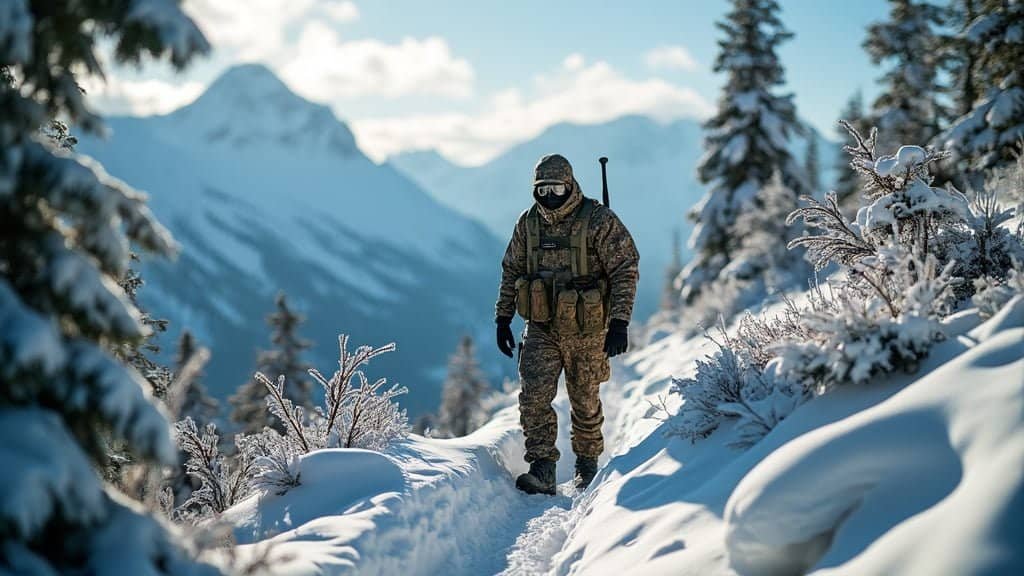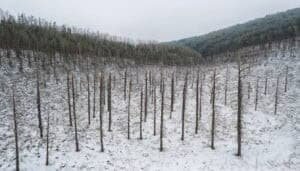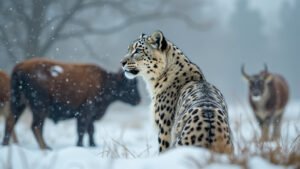Introduction
Snow leopards, known for their elusive nature and majestic presence, are facing a severe threat from poaching. This article delves into the current population status of snow leopards and the prevalence of poaching in their habitats
We will explore the impact of poaching on their behavior and ecology, review the anti-poaching measures in place, and highlight the crucial roles of organizations and local communities in conservation efforts
Current Population of Snow Leopards
Snow leopards (Panthera uncia), often referred to as the “ghosts of the mountains,” are native to the mountain ranges of Central and South Asia
Despite their elusive nature, scientific efforts have provided estimates of their current population, revealing the stark reality of their dwindling numbers
What Are the Latest Population Estimates?
As of recent assessments, the global population of snow leopards is estimated to be between 4,000 and 6,500 individuals
This estimate is based on extensive field surveys and camera trap data collected across their range, which spans 12 countries including China, India, Mongolia, and Russia. According to the Snow Leopard Trust, these numbers are worrying, as they represent a significant decline over the past few decades due to various anthropogenic pressures
Factors Influencing Population Numbers
Several factors contribute to the fluctuation in snow leopard population numbers. Habitat loss due to human encroachment, climate change affecting prey availability, and poaching are primary drivers
Human-wildlife conflict also plays a significant role, as livestock depredation often leads to retaliatory killings by local herders. Additionally, the illegal wildlife trade has targeted snow leopards for their pelts and bones, further exacerbating their decline
Habitat fragmentation, driven by infrastructure development like roads and mining, disrupts the snow leopards’ natural territories and breeding grounds. Climate change also affects the distribution of their prey, such as blue sheep and ibex, pushing these predators to venture closer to human settlements in search of food, thereby increasing the likelihood of conflict
Historical Population Trends
Historically, snow leopard populations were more robust. However, over the last century, their numbers have seen a dramatic decline
Reports suggest that in the 1970s, snow leopard numbers were considerably higher, but a lack of effective conservation measures and rampant poaching led to a significant reduction. By the 1990s, the situation had become critical, prompting international conservation efforts
Efforts by organizations such as the Snow Leopard Trust, Panthera, and the World Wildlife Fund (WWF) have led to the implementation of several conservation programs aimed at stabilizing and increasing snow leopard populations. These programs focus on habitat preservation, reducing human-wildlife conflict, and combating illegal poaching through community involvement and enhanced law enforcement
Prevalence of Poaching in Snow Leopard Habitats
Poaching poses a significant threat to snow leopards, driven by various socio-economic and cultural factors. Understanding the extent and drivers of poaching is crucial for developing effective conservation strategies
Regions Most Affected by Poaching
Poaching incidents are not evenly distributed across the snow leopard’s range. Certain regions, such as the mountains of Central Asia, particularly in Kyrgyzstan, Tajikistan, and parts of Mongolia, report higher rates of poaching
These areas are often characterized by economic hardship, where local communities may resort to poaching as a source of income. The illegal wildlife trade, particularly in countries like China and Russia, fuels the demand for snow leopard pelts and body parts used in traditional medicine and as trophies
In India and Nepal, the Himalayas serve as another hotbed for snow leopard poaching. Despite legal protections, enforcement is challenging due to the remote and rugged terrain, which makes monitoring and patrolling difficult. Cross-border poaching networks further complicate efforts to curb this illegal activity
Statistics on Poaching Incidents
Quantifying poaching incidents is challenging due to its illicit nature. However, research by TRAFFIC, the wildlife trade monitoring network, estimates that hundreds of snow leopards are killed annually due to poaching
A 2016 report by TRAFFIC and the Snow Leopard Trust revealed that between 220 and 450 snow leopards were poached each year over the previous decade . These figures likely represent a fraction of the actual numbers, as many incidents go unreported
Causes and Drivers of Poaching
Several factors drive the poaching of snow leopards:
Economic Incentives: In regions where poverty is prevalent, poaching offers a lucrative income. The high market value of snow leopard pelts and bones incentivizes illegal hunting
Human-Wildlife Conflict: Snow leopards sometimes prey on livestock, leading to retaliatory killings by herders protecting their livelihood. This conflict is a significant driver of snow leopard poaching
Illegal Wildlife Trade: Demand for snow leopard parts in traditional medicine and luxury markets, particularly in Asia, fuels poaching. Pelts are often sold as luxury items, while bones and other body parts are used in traditional remedies
Cultural Practices: In some cultures, possessing snow leopard pelts or other parts is seen as a status symbol, further driving illegal hunting
Impact of Poaching on Snow Leopard Behavior and Ecology
Poaching not only reduces the number of snow leopards but also has profound effects on their behavior and the ecosystems they inhabit. These impacts can alter the dynamics of predator-prey relationships and disrupt the ecological balance in their habitats
Changes in Snow Leopard Behavior
Poaching can cause significant behavioral changes in snow leopards. Due to the constant threat of poaching, snow leopards may become more elusive and alter their natural behaviors to avoid human encounters
They may shift their activity patterns, becoming more nocturnal to reduce the risk of being spotted by poachers. This increased wariness and change in behavior can affect their hunting efficiency and overall well-being
In regions with high poaching pressure, snow leopards may also alter their home ranges, moving to more remote and less accessible areas. This displacement can lead to increased competition for resources among individuals and a higher likelihood of conflicts with other predators or human settlements
Ecological Consequences of Poaching
The removal of snow leopards from their natural habitats through poaching has cascading effects on the ecosystem. As apex predators, snow leopards play a crucial role in maintaining the balance of their ecosystems by regulating prey populations
When snow leopard numbers decline, there can be an overpopulation of herbivores such as blue sheep and ibex, leading to overgrazing and degradation of vegetation
This imbalance can have far-reaching consequences, affecting other wildlife species and the overall health of the ecosystem. For example, overgrazing by herbivores can reduce the availability of forage for other herbivores and impact the habitat quality for smaller mammals and birds
Additionally, the loss of snow leopards can disrupt the predator-prey dynamics, potentially leading to an increase in other predator populations such as wolves or feral dogs
Case Studies on Poaching Impacts
Several case studies highlight the severe impact of poaching on snow leopards and their ecosystems
In Mongolia’s South Gobi region, a study by McCarthy and Chapron (2003) found that poaching significantly reduced snow leopard populations, leading to an increase in livestock depredation as leopards sought alternative food sources. This increased conflict further exacerbated retaliatory killings, creating a vicious cycle
In Kyrgyzstan, the Argali Project conducted by the Snow Leopard Trust documented the effects of poaching on snow leopard prey populations
The study found that the decline in snow leopard numbers due to poaching led to an overabundance of Argali sheep, resulting in overgrazing and habitat degradation. This not only affected the vegetation but also had negative impacts on other herbivores and the overall biodiversity of the region
Anti-Poaching Measures and Conservation Efforts
To mitigate the threat of poaching and ensure the survival of snow leopards, a variety of anti-poaching measures and conservation efforts have been implemented. These strategies involve collaboration among governments, NGOs, local communities, and international organizations
Current Anti-Poaching Strategies
Effective anti-poaching strategies are multifaceted, combining law enforcement, technology, community involvement, and international cooperation:
Law Enforcement: Strengthening legal frameworks and enhancing enforcement capabilities are crucial. Countries within the snow leopard’s range have implemented stricter penalties for poaching and illegal wildlife trade. Patrolling by trained rangers and wildlife officials has been intensified in critical habitats
Technology: The use of advanced technology has revolutionized anti-poaching efforts. Camera traps, GPS collars, and drones are employed to monitor snow leopard populations and detect poaching activities. Organizations like Panthera and the Snow Leopard Trust use these technologies to gather real-time data and track movements
Community Involvement: Engaging local communities is essential for the success of anti-poaching initiatives. Programs that provide alternative livelihoods, such as eco-tourism and handicraft production, reduce the economic incentive for poaching. Community-based monitoring, where locals are trained to report poaching incidents, has also proven effective
International Cooperation: Cross-border collaboration is vital, given the wide range of snow leopard habitats. International agreements and partnerships facilitate the sharing of information and resources. The Global Snow Leopard and Ecosystem Protection Program (GSLEP) is a notable example, uniting all 12 snow leopard range countries in a joint conservation effort
Effectiveness of Conservation Programs
Conservation programs have shown varying degrees of success, with several notable achievements:
Snow Leopard Trust: This organization has been instrumental in reducing poaching through its community-based conservation programs. In regions like the South Gobi in Mongolia, their initiatives have led to a significant decrease in poaching incidents and increased local support for snow leopard conservation
Panthera’s Snow Leopard Program: Panthera’s approach combines scientific research with practical conservation measures. Their efforts in Kyrgyzstan and Tajikistan, for example, have included installing camera traps and engaging local communities, resulting in better monitoring and protection of snow leopard populations
World Wildlife Fund (WWF): WWF’s comprehensive conservation strategy focuses on habitat preservation, anti-poaching efforts, and community engagement. Their projects in the Himalayas have helped stabilize snow leopard populations through habitat restoration and conflict mitigation
Role of Technology in Anti-Poaching Efforts
Technology has become a cornerstone in the fight against poaching:
Camera Traps and GPS Collars: These tools provide invaluable data on snow leopard movements, behavior, and population density. Camera traps, in particular, help identify poaching hotspots and monitor the presence of both predators and prey
Drones: Unmanned aerial vehicles (drones) are used to patrol remote and rugged terrains where traditional monitoring is challenging. Drones can cover large areas quickly, providing real-time surveillance and deterring potential poachers
Data Analysis: Advanced data analytics and machine learning algorithms analyze patterns from collected data, predicting poaching risks and optimizing patrol routes. Organizations like SMART (Spatial Monitoring and Reporting Tool) integrate these technologies to enhance the effectiveness of ranger patrols
Role of Organizations and Local Communities
The success of snow leopard conservation largely depends on the collaborative efforts of organizations and local communities. These stakeholders play critical roles in protecting these elusive predators and their habitats
Key Organizations in Snow Leopard Conservation
Several prominent organizations are at the forefront of snow leopard conservation, implementing various strategies to protect these majestic animals:
Snow Leopard Trust: Established in 1981, the Snow Leopard Trust is one of the leading organizations dedicated to the conservation of snow leopards. They work in five key range countries: China, India, Kyrgyzstan, Mongolia, and Pakistan. The Trust focuses on research, community-based conservation, and building local capacity to address the threats faced by snow leopards
Panthera: Panthera’s Snow Leopard Program aims to safeguard snow leopards through scientific research, habitat protection, and community engagement. Their work in Central Asia, particularly in Kyrgyzstan and Tajikistan, has been instrumental in understanding snow leopard ecology and reducing poaching through the implementation of camera traps and community patrols
World Wildlife Fund (WWF): WWF’s snow leopard conservation efforts span several countries, including Nepal, Bhutan, and Mongolia. WWF focuses on habitat preservation, anti-poaching initiatives, and fostering human-wildlife coexistence. Their projects include securing protected areas, restoring degraded habitats, and promoting sustainable livelihoods for local communities
Global Snow Leopard and Ecosystem Protection Program (GSLEP): Launched in 2013, GSLEP is a unique alliance of all 12 snow leopard range countries, supported by international organizations such as the United Nations Development Programme (UNDP) and the World Bank. GSLEP aims to secure 20 snow leopard landscapes by 2020, focusing on habitat preservation, reducing human-wildlife conflict, and enhancing international cooperation
Community Involvement and Education Programs
Engaging local communities is vital for the long-term success of snow leopard conservation. Community involvement and education programs help reduce human-wildlife conflict and foster a sense of stewardship among local populations:
Livelihood Programs: Many conservation organizations implement livelihood programs that provide alternative income sources for communities, reducing their reliance on poaching. These programs include initiatives like handicraft production, eco-tourism, and livestock insurance schemes. For example, the Snow Leopard Trust’s handicraft program in Mongolia has provided sustainable incomes for herder families while promoting snow leopard conservation
Community-Based Monitoring: Local communities are often the first to detect poaching activities. Training community members to monitor snow leopard populations and report illegal activities has proven effective. In Kyrgyzstan, community rangers patrol critical habitats, using camera traps and other technologies to gather data and deter poachers
Education and Awareness: Raising awareness about the importance of snow leopards and the threats they face is crucial. Education programs targeting schools, local leaders, and the general public help build support for conservation efforts. The Snow Leopard Trust’s eco-camps in India and Mongolia educate children about wildlife conservation and foster a connection to their natural heritage
Success Stories and Challenges
Several success stories highlight the positive impact of collaborative conservation efforts:
South Gobi Conservation Project: In Mongolia’s South Gobi region, the Snow Leopard Trust’s community-based conservation programs have led to a significant decrease in poaching incidents. The project involves local herders in monitoring snow leopard populations and provides alternative livelihoods, resulting in increased community support for conservation
Annapurna Conservation Area: In Nepal, WWF’s efforts in the Annapurna Conservation Area have helped stabilize snow leopard populations. Through habitat restoration, anti-poaching patrols, and community engagement, WWF has successfully reduced human-wildlife conflict and promoted sustainable development
Despite these successes, challenges remain:
Resource Limitations: Many conservation programs face funding and resource constraints, limiting their ability to scale up efforts and cover larger areas
Human-Wildlife Conflict: Ongoing conflicts between snow leopards and local communities over livestock predation continue to pose challenges. Effective conflict mitigation strategies are essential to gain community support
Illegal Wildlife Trade: The demand for snow leopard parts in traditional medicine and luxury markets remains a significant threat. Strengthening law enforcement and international cooperation is critical to combat this illegal trade
Conclusion
The survival of snow leopards is intricately tied to the effectiveness of conservation efforts and the commitment of local and international communities
Poaching remains a critical threat, significantly reducing snow leopard populations and disrupting their natural behaviors and ecological roles. Through comprehensive measures, including enhanced law enforcement, technological advancements, and robust community engagement, strides have been made to protect these majestic creatures
Organizations such as the Snow Leopard Trust, Panthera, and WWF play pivotal roles in implementing conservation strategies and fostering collaboration across borders
The involvement of local communities is vital, as they are often the first line of defense against poaching and habitat destruction. Education and livelihood programs have empowered these communities, providing sustainable alternatives to poaching and promoting coexistence with snow leopards. Despite the successes, challenges such as human-wildlife conflict and the illegal wildlife trade persist, requiring continuous adaptation and support
Protecting snow leopards demands a multifaceted approach that addresses both immediate threats and long-term sustainability
Through ongoing efforts and global cooperation, there is hope for the preservation of snow leopards and the ecosystems they inhabit, ensuring these elusive “ghosts of the mountains” continue to roam their natural habitats for generations to come











